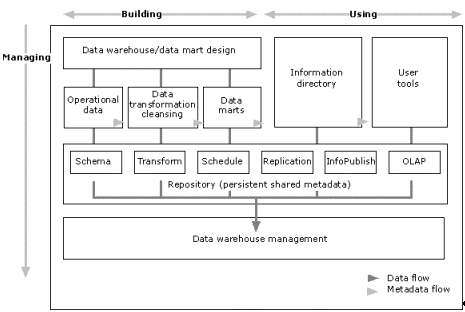
Microsoft Corporation
April 1999
Summary: Introduction to online analytical processing (OLAP) and Microsoft® SQL Server™ OLAP Services. Covers OLAP terminology and concepts and OLAP Services architecture, and discusses several challenges to OLAP implementation. (17 printed pages)
Introduction
Rationale for OLAP Systems
OLAP Terms and Concepts
OLAP Services Architecture
Challenges of OLAP Implementation
Conclusion
Online analytical processing (OLAP) is an increasingly popular technology that can dramatically improve business analysis, but that has also been characterized historically by expensive tools, difficult implementation, and inflexible deployment. Microsoft has tackled the OLAP problem and created a solution that makes multidimensional analysis accessible to a broader audience and at a potentially significantly lower cost of ownership.
Microsoft® SQL Server™ OLAP Services is a fully featured OLAP capability that is a component of Microsoft SQL Server 7.0. OLAP Services includes a middle-tier server that allows users to perform sophisticated analyses on large volumes of data with exceptional performance. A second feature of OLAP Services is a client cache and calculation engine called PivotTable® Service, which helps improve performance and reduce network traffic. PivotTable Service allows users to conduct analyses while disconnected from the corporate network.
OLAP is a key component in the data warehousing process, and OLAP Services provides essential functionality for a wide array of applications ranging from corporate reporting to advanced decision support. The inclusion of OLAP functionality within SQL Server helps make multidimensional analysis more affordable and brings the benefits of OLAP to a wider audience. That audience includes not only smaller organizations, but also groups and individuals within larger corporations that have been excluded from the OLAP industry by the cost and complexity of today's products.
Coupled with a wide variety of tools and applications that support OLAP applications through the Microsoft OLE DB for OLAP interface, OLAP Services increases access to sophisticated analytical tools and can reduce the costs of data warehousing.
Historically, the bulk of investment in corporate computing has been in systems that generate or capture data, such as accounting, order processing, manufacturing, and customer information. Increasingly, organizations are investing in applications and technologies that deliver additional value from this collected data. Data warehousing is the process of collecting, cleansing, and sifting data from a variety of operational systems and making the resultant information available to a wide audience of end users for analysis and reporting. Data warehouse and data mart are both used to describe these nonvolatile stores of cleansed and summarized information that are available for browsing by users.
Several years ago, Microsoft undertook a pair of initiatives with the overall goal of expanding the availability of data warehousing and decision support capabilities in the business world. The two initiatives are the Microsoft Data Warehousing Framework, a roadmap for Microsoft product development, and the Microsoft Alliance for Data Warehousing, a coalition of industry businesses that are committed to the Microsoft platform and the Data Warehousing Framework for development and marketing. The initiatives were based on Microsoft's central strategy of contributing to the data warehousing process by:
The Data Warehousing Framework is an open architecture that describes mechanisms for sharing data and metadata in the construction and management of data warehouses and data marts. The essential technologies underlying the Data Warehousing Framework are the OLE DB data interfaces and the instance of Microsoft Repository running on SQL Server.
Microsoft Repository is a database that stores descriptive information about software components and their relationships (metadata). Metadata models have been defined in Microsoft Repository for database schemas, data transformations, and OLAP database schemas.
The Data Warehousing Framework components represent integral steps in the data warehousing process, some of which are delivered by Microsoft but can be extended easily by Microsoft customers and third-party businesses using alternative technology.
SQL Server 7.0 provides many of the basic components required for building and maintaining a data warehouse. These include database design with a graphical schema designer; high-capacity data storage; data transformation capabilities through Data Transformation Services (DTS); and OLAP capabilities through OLAP Services.

Figure 1. Data Warehousing Framework
For more information about the Microsoft Data Warehousing Framework, see "Microsoft SQL Server 7.0 Data Warehousing Framework" (part number 098-80704).
Despite the data warehousing process of preparing data for end-user consumption, most information in a relational data warehouse is not easily found. Often the data structures are difficult for the end user to comprehend, or the questions (such as "Who are the top sales people in each region for the last year by month?") are complex when expressed in SQL. Some challenges can be addressed with advanced query tools, which hide the database complexity from the end user. However, for a large class of applications where the end user is viewing multidimensional data, Microsoft believes the optimal solution is OLAP technology.
All organizations have multidimensional data, and complexity is not necessarily a function of company size. Even the smallest company would like to track sales by product, salesperson, geography, customer, and time. Organizations have long sought tools to access, navigate, and analyze multidimensional data in an easy, natural way.
OLAP is not a new concept, but the OLAP name has only recently been given to this technology. In 1993, Dr. E. F. Codd, the database researcher and inventor of the relational database model, coined the term in his white paper, "Providing OLAP to User Analysis: An IT Mandate," wherein he laid out 12 rules that defined the characteristics of OLAP applications. Nigel Pendse and Richard Creeth of the OLAP Report (www.olapreport.com/DatabaseExplosion.htm) later refined his definition with what is called the FASMI test, which means simply that OLAP applications should deliver fast analysis of shared multidimensional information. To break that statement down into its parts:
OLAP provides organizations with a means of accessing, viewing, and analyzing data with high flexibility and performance. First and foremost, OLAP presents data to end users through a natural, intuitive data model. With this navigational style, end users can more effectively view and understand the information in their data warehouses, thereby allowing organizations to better recognize the value of their data.
Second, OLAP accelerates the delivery of information to end users viewing these multidimensional structures by preparing some computed values in the data in advance, rather than at execution time. The combination of easy navigation and fast performance allows end users to view and analyze data more quickly and efficiently than is possible with relational database technology only. The end result: More time is spent analyzing data and less time spent analyzing databases.
It is important to define and clarify common terms and concepts used in discussions about OLAP.
In an OLAP data model, information is viewed conceptually as cubes, which consist of descriptive categories (dimensions) and quantitative values (measures). The multidimensional data model makes it simple for users to formulate complex queries, arrange data on a report, switch from summary to detail data, and filter or slice data into meaningful subsets. For example, typical dimensions in a cube containing sales information would include time, geography, product, channel, organization, and scenario (budget or actual). Typical measures would include dollar sales, unit sales, inventory, headcount, income, and expense.

Figure 2. A Data Cube
Within each dimension of an OLAP data model, data can be organized into a hierarchy that represents levels of detail on the data. For example, within the time dimension, you may have these levels: years, months, and days; similarly, within the geography dimension, you may have these levels: country, region, state/province, and city. A particular instance of the OLAP data model would have the specific values for each level in the hierarchy. A user viewing OLAP data will move up or down between levels to see more or less detailed information.
Cubes, dimensions, hierarchies, and measures are the essence of the multidimensional navigation of OLAP. By describing and presenting data in this fashion, users can intuitively navigate a complex set of data. However, simply describing the data model in a more intuitive representation does little to help deliver the information to the user more quickly.
A key tenet of OLAP is that users should see consistent response times for each view, or slice, of the data they request. Because data is normally collected at the detail level only, the information summary usually is computed in advance. These precomputed values, or aggregations, are the basis of the OLAP performance gains.
In the early days of OLAP technology, most vendors assumed that the only possible solution for OLAP applications was a specialized, nonrelational storage model. Later, other vendors discovered that through the use of database structures (star and snowflake schemas), indexing, and storage of aggregates, relational database management systems (RDBMS) could be used for OLAP. These vendors called their technology relational OLAP (ROLAP). The earlier OLAP vendors then adopted the term multidimensional OLAP (MOLAP).
MOLAP implementations usually outperform ROLAP technology, but have problems with scalability. On the other hand, ROLAP implementations are more scalable and are often attractive to customers because they leverage investments in existing relational database technology.
A recent development has been a hybrid OLAP (HOLAP) solution, which combines the ROLAP and MOLAP architectures to yield a solution with the best features of both: superior performance and extensive scalability. One approach to HOLAP maintains detail records (the largest volumes) in the relational database, while maintaining aggregations in a separate, MOLAP store.
Microsoft SQL Server OLAP Services has been designed from the ground up to help minimize the most significant ownership costs of building and maintaining OLAP applications. OLAP Services consists of both server and client (middle-tier) software components.
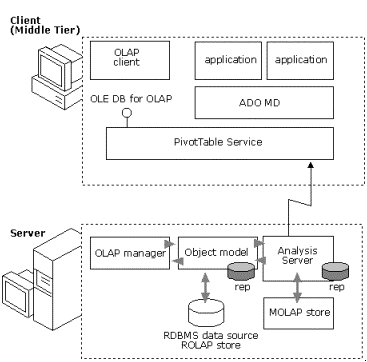
Figure 3. OLAP Service Architecture
On the server side, the OLAP Services OLAP server operates as a Microsoft Windows NT® service and provides the core computational functionality. Programmatic access to administrative functions in the OLAP server is through an object model called Decision Support Objects (DSO), which is documented by Microsoft.
OLAP Manager, the built-in administrative user interface for OLAP Services, is also developed on DSO and provides a rich user experience without the need for programming. OLAP Manager, which can execute on a computer separate from the OLAP server, allows the database administrator to design OLAP data models, access information in RDBMS stores, design aggregations, and populate OLAP data stores, among other functions. The OLAP metadata definitions are stored in a private repository, but can be exported to Microsoft Repository with the OLAP Open Information Model (OIM) by using a simple utility.
OLAP Services can access source data in any supported OLE DB data provider, which including not only SQL Server but also a large number of desktop and server databases, including Microsoft Access, Microsoft FoxPro®, Oracle, Sybase, and Informix. Any database source that provides an Open Database Connectivity (ODBC) interface is also accessible through a facility in OLE DB that wraps ODBC drivers and exposes them as if they were native OLE DB interfaces. These data sources can also reside on platforms other than the Windows NT operating system, for example, UNIX or mainframe systems and IBM DB2 or Teradata databases. Through the multiplatform capabilities of OLE DB, data can be accessed from a wide variety of systems as if they were local to the OLAP Services server.
On the client side, OLAP Services includes a component called PivotTable Service. PivotTable Service is the facility that connects OLAP client applications to the OLAP Services server. All access to data managed by OLAP Services, by custom programs or client tools, is through the OLE DB for OLAP interface provided by PivotTable Service.
Both the client and server components of OLAP Services are extensible in functionality. Customer sites, independent software vendors (ISVs), and consultants can all extend the calculation, data management, or application functionality using the well-documented features in DSO. With this built-in extensibility, customers can be assured that OLAP Services will have the functionality necessary to address their application needs.
Implementation of OLAP presents several challenges that must be overcome.
A fundamental challenge in OLAP implementation is mapping the initial database schema to the multidimensional model. This requires a significant programming effort with many of the products on the market today. In the evolution of OLAP products, OLAP database design has become a specialized and arcane process, intricately linked to the specific OLAP technology being deployed. Consequently, OLAP database developers are very specialized, which has led to high costs in developing applications, concentrated at the data design stage.
In most OLAP implementations, it is assumed that the data has been prepared for analysis through data warehousing, whereby information has been extracted from operational systems, cleansed, validated, and summarized prior to incorporation into an OLAP application. This is a vital step in the process, ensuring that the data being viewed by the OLAP user is correct, consistent, and matches organizational definitions for data.
Increasingly, information in a data warehouse is organized in star or snowflake schemas, which simplify user understanding of the data, maximize database query performance for decision support applications, and require less storage for large databases.
The following illustration is an example of a star schema. In this type of database schema, a central fact table is linked to related dimension tables.
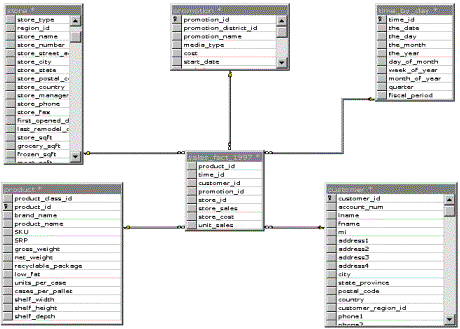
Figure 4. A Star Schema
Star and snowflake schemas are relational approximations of the OLAP data model and can be an excellent starting point for building OLAP cube definitions. Few OLAP products, however, have taken advantage of this trend. They generally have not provided easy tools to map a star schema to an OLAP model, and as a result keep the cost of building OLAP models extremely high and the development time unnecessarily long.
One of the key features in OLAP Services is the OLAP Manager user interface, which has been created with the infrequent OLAP database administrator in mind. The OLAP Manager is delivered as a snap-in to the Microsoft Management Console (MMC), and it shares the same administrative user interface as the entire Microsoft BackOffice® family. The obvious benefit is that the OLAP database administrator is better able to translate skills from SQL Server and other Microsoft products.
The value becomes more apparent when one understands the power and flexibility of MMC. OLAP Services includes a full range of taskpads that guide the novice or infrequent user through common tasks. Included in OLAP Services is a full tutorial on OLAP concepts and a step-by-step guide to building an OLAP cube. A full complement of wizards is available for automating the most common activities, such as creating a dimension definition.
Furthermore, OLAP Services is optimized for development of data warehouses where star or snowflake schemas have been designed. The Cube Wizard is especially suited to these prebuilt schemas, and translation to the multidimensional model is extremely rapid. OLAP Services can easily accommodate other source schemas should they be encountered.
To ensure successful interpretation of the OLAP Services user interface concepts, Microsoft labs conducted a substantial number of usability tests. Finally, large-scale beta testing has provided broad exposure and customer input to OLAP Services. As a result of the energy spent on the database administrator requirements, most users are able to build their first cube in less than 30 minutes.
As noted earlier, precomputing aggregations is a key performance strategy for most OLAP products. However, preaggregation comes at a significant cost: the number of aggregations can easily outstrip the number of initial detail points, and the volume of data stored expands dramatically. The number of aggregations in an OLAP model is a function of the number of dimensions, the number of levels in the hierarchies, and the parent-child ratios. For more information, see the OLAP Report analysis at www.olapreport.com/DatabaseExplosion.htm.
Real-world examples of the effects of this data explosion abound. A recently published standard benchmark test of another OLAP product resulted in a data explosion factor of 240, requiring 2.4 gigabytes (GB) of storage to manage 10 megabytes (MB) of input data. Providing adequate disk storage to handle the huge expansion in data is a significant cost of large-scale OLAP implementations, and it creates distinct limits on the ability of an organization to analyze all the source-level data desired.
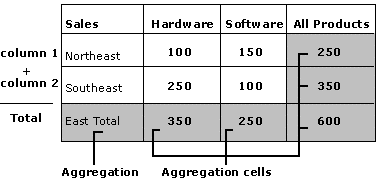
Figure 5. Aggregation
Because of data explosion, OLAP applications can suffer even more when the source or detail data is sparsely distributed throughout the multidimensional cube. Missing or invalid data values create sparsity in the OLAP data model. In the worst case, an OLAP product would nonetheless save an empty value. For example, a company may not sell all products in all regions, so no values would appear at the intersection where products are not sold in a particular region.

Figure 6. Data Sparsity
Data sparsity, a challenge for OLAP vendors, has been met with varying degrees of success. The worst implementation results in databases that store empty values, thus having low density and wasting space and resources. OLAP Services does not store empty values, and as a result, even sparsely populated cubes will not balloon in size. While this issue is frequently highlighted by some OLAP vendors as a deciding factor in OLAP architectures, the differences between vendor implementations of sparsity management is minor compared to the more significant data explosion caused by precalculating too many aggregates.
Microsoft believes OLAP Services leads the market in offering flexible solutions that allow the OLAP database administrator to decide which storage model is most appropriate. OLAP Services supports a full MOLAP implementation, full ROLAP implementation, or a HOLAP solution. For example, a database administrator may opt to put frequently accessed data in MOLAP and may place historical data, which has more scalability problems, in ROLAP. However, the underlying data model is completely invisible to the client application, and its user perceives only cubes.
Whether one chooses to implement a MOLAP, ROLAP, or HOLAP data model, Microsoft thinks the integration of OLAP Services with relational databases is superior. By tying the graphical user interface design tools and wizards directly to OLE DB, OLAP Services maintains strong links between the source data, the OLAP multidimensional metadata, and the aggregations themselves.
When implementing ROLAP data models, OLAP Services defines, populates, and maintains all of the relational database structures. This frees the developer from having to perform these tasks, or worse, from having to manage complex queries across multiple tables and servers.
OLAP Services has also minimized a fundamental problem of OLAP technology: data explosion caused by excessive preaggregation. As described earlier, OLAP data explosion is the result of multidimensional preaggregation. In traditional OLAP systems, unless it is calculated at run time, data that has not been preaggregated is not available for reporting and analysis. By precalculating and storing all possible combinations of aggregates (for example, the sum of all products and product levels across all time periods, across all organizations, across all distribution channels, and so on), traditional OLAP products result in a massive data explosion.
In contrast to the approach of calculating all possible aggregations, OLAP Services determines which aggregations provide the greatest performance improvements, but also enables the OLAP database administrator to make a trade-off between system speed and the disk space required to manage aggregations through the Storage Design Wizard. If the developer were to precalculate all aggregations, disk space requirements would be maximized (hence the data explosion syndrome). On the other hand, if the developer were to precalculate nothing, disk requirements would be zero, but performance would not be improved.
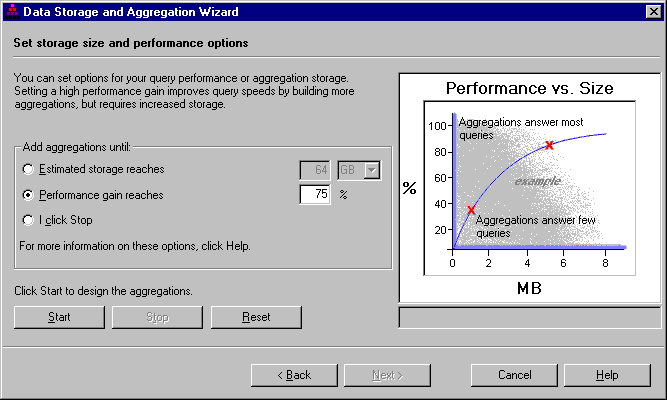
Figure 7. Data Storage and Aggregation Wizard
In most cases, OLAP Services can gain about 80 percent improvement in query performance without excessive precomputation of aggregations (the exponential explosion of data typically occurs during the last 20 percent of aggregations). OLAP Services analyzes the OLAP metadata model and heuristically determines the optimum set of aggregations from which all other aggregations can be derived. The result is that OLAP Services derives nonaggregated data from a few existing aggregate values rather than having to scan the entire data warehouse. This strategy of partial preaggregation, however, is only the starting point.
Although the OLAP Services heuristics are excellent, they are based on mathematical models that may or may not correspond to actual usage patterns. To optimize performance according to actual usage patterns, OLAP Services optionally logs queries sent to the server. These logs can then be used to fine-tune the set of aggregations that OLAP Services maintains. For example, the Usage-Based Optimization Wizard enables the database administrator to tell OLAP Services to create a new set of aggregations for all queries that take longer than n seconds to answer (where n might be 10 seconds or more).
In many organizations, processing time is of greater concern than disk space. One can always buy more disk space, but if it takes a day to process a day's worth of new data, there simply is not any more time to buy. The OLAP Services solution to data explosion, however, reduces the time required to process initial loads and incremental updates, as well as minimizing the amount of disk space necessary. If an application begins with a 10-GB data warehouse and generates 10 GB of aggregations, then the processing time required is a fraction of that which would be required to process the fully exploded set of aggregations.
OLAP Services also has taken an innovative approach to data sparsity. While the details of the internal implementation are proprietary, the net result is that both MOLAP and ROLAP implementations manage storage requirements extremely well, often resulting in databases with smaller OLAP storage needs than the original detail data.
Virtual cubes can be used whenever the user wants to view joined information from two dissimilar cubes that share as little as one common dimension. Similar in concept to a relational view, virtual cubes are two or more cubes linked at query time along one or more common dimensions. One benefit of virtual cubes applies to situations where data sparsity is a significant problem. For example, a cube that contains measures for sales by unit and selling price could also have a measure for list price to compute discounts, but the list price value would be repeated many times. By building a list price cube that is joined in a virtual cube with the sales by unit and selling price information, the database administrator can eliminate much of the data redundancy. The ability to create virtual cubes means that many unnecessary values can be eliminated from the OLAP data storage altogether.
The specific performance metrics of an OLAP application are a function of several factors, including database size, hardware computing power, and disk space allocated to preaggregated data. However, in real-world implementations, OLAP Services-based applications respond to most queries in less than five seconds and to nearly all queries within 10 seconds.
The OLAP Services implementation of partitioned cubes makes the technology highly scalable. A partitioned cube enables one logical cube of data to be spread over multiple physical cubes and even separate physical servers. In response to a user query, OLAP Services distributes the query among the partitioned servers, allowing the data to be retrieved in parallel.
For example, consider the case of an application tracking telephone calls for 10 geographic regions, where one would expect several million calls per day. For the purpose of analysis, one could partition the data among 10 servers, each containing the data for a particular region. From the user perspective, however, there is simply one logical cube of data. In response to user requests for this information, OLAP Services seamlessly transforms the queries as appropriate for each of the 10 servers and returns a single result set to the user. Each of the 10 databases would also be available for separate access by analysts seeking information for that particular region. Microsoft believes that the ability of OLAP Services to efficiently manage data partitioned across multiple servers will make the technology more scalable than many competing offerings.
Historically, OLAP server technology has been tightly linked to proprietary client technology, meaning that customers have had little choice in their selection of mixed, best-of-breed products. This linkage has led to high implementation costs and often inadequate choices for applications that require both client/server and Web-based OLAP information delivery. As was recognized a number of years ago in the relational database industry, a common interface is necessary to promote openness in the selection of applications and databases. The industry standard became ODBC.
The issue of openness in OLAP tools was first taken up in 1996, when a vendor consortium called the OLAP Council announced an interoperability standard, multidimensional application programming interface (MDAPI), which was meant to open the marketplace to greater vendor participation. In spite of much customer anticipation, the vendor community, including the members of the OLAP Council, generally shunned MDAPI.
Recognizing the need for a unifying standard that leveraged existing customer investments, Microsoft set out to extend the definition of the existing OLE DB data access API to include multidimensional capabilities. In one year, Microsoft published two drafts of the API, sought feedback from vendors and the public, and in February 1998 ultimately delivered a final version that was endorsed by 18 vendors at beta release.
Today, the OLE DB for OLAP API has the support of more than 30 vendors, many of which are listed on the Microsoft Web site at www.microsoft.com/data/oledb/olap. This list includes nearly every member of the now-declining OLAP Council. Many of these vendors already are delivering beta products based on the specification to OLAP Services users. For an index of the vendors with products currently supporting Microsoft SQL Server OLAP Services, see www.microsoft.com/sql/70/gen/olap.htm.
Many analysts need to analyze data multidimensionally while disconnected from the corporate network, such as when traveling with a laptop computer. Disconnected users typically want to view and analyze small slices of their entire cube, for example, a sales manager viewing a revenue summary for a particular region while visiting a regional office. The need is so common that desktop OLAP (DOLAP), which does not require a shared server for multidimensional data access, was created.
Most OLAP server technologies do not provide transparent creation of DOLAP cubes. As a result, this step has been left as yet another development-intensive effort or relegated to OLAP client tools that have by necessity added OLAP functionality to support desktop usage. Overall, this condition has increased the cost and complexity of delivering applications that require both connected and disconnected clients.
A popular viewing tool for any type of information, especially multidimensional information, is a Web browser. A key means of reducing the cost per user in large-scale OLAP applications, Web browsers open the world of multidimensional access to a wider audience. At present, there are some very good products and tools for delivering OLAP data over an intranet, but there is no easy mechanism for an application developer to create custom OLAP viewing tools.
The OLAP Services server caches user queries and metadata as well as data. Cached query definitions and metadata make it possible for OLAP Services to answer new queries by calculating previously cached data rather than accessing the disk. For example, one user asks for sales data for January, February, and March. Another user asks for sales data for the first quarter. OLAP Services can summarize January through March from random access memory (RAM) faster than it can fetch the first-quarter data from disk.
OLAP Services is unusual in that it provides much of the same functionality on the client. Every client connects to OLAP Services servers by using PivotTable Service. PivotTable Service acts as a driver to manage the connection between the client and server. PivotTable Service shares much of the same code as the OLAP Services server, bringing the server's multidimensional calculation engine, caching features, and query management directly to the client. The result is an innovative client/server data-management model that optimizes performance and minimizes network traffic. This comes at a very small computing cost: the disk space required for PivotTable Service is approximately 2 MB, and the memory requirements are only 500K in addition to the cached data.
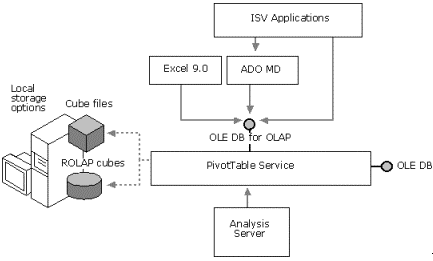
Figure 8. Pivot Table Service
The OLAP Services intelligent client/server architecture is capable of determining how to answer a user request as quickly as possible and eliminating redundant network traffic. The key to this architecture is shared metadata between client and server. When a user requests information from the server, both data and metadata (definitions of the cube structure) are downloaded to the client. Having the cube metadata present on the client allows PivotTable Service to resolve what requests need to be returned to the server for resolution.
For example, recall the three-month sales data scenario. Assume that both the OLAP Services server and the client application have just been started. When the user asks for sales data for January, February, and March, the data will be cached on both the server and the client. If the user then asks for data for the first quarter, PivotTable Service will derive the results locally (at the client) without sending the query to the server. If the user subsequently asks to see data from the first quarter of this year compared to that of last year, PivotTable Service has the intelligence to access the server for last year's data only.
PivotTable Service also provides the mechanism for disconnected usage. Portions of cubes defined and accessed from a server can be saved on the client for later access when disconnected from the network. In this way, business users can take portions of their database while travelling and still have complete analysis capabilities. In addition, PivotTable Service allows users to create simple OLAP models locally, accessing information in OLE DB compatible data sources, from flat files to desktop databases.
Finally, PivotTable Service provides the connectivity for Web-based applications. While OLE DB for OLAP is a low-level programming interface, a new extension to ActiveX® Data Objects (ADO) provides multidimensional data access. This extension, called ADO/MD, can be used to create ActiveX controls in the Microsoft Visual Basic® development system to browse, chart, or report on data in OLAP Services from a Web page. ADO/MD is the corporate application programmer's tool for gaining access to the full functionality of OLAP Services.
OLAP Services breaks all cost expectations. Typically, OLAP products can cost $50,000 to $100,000 for less than 50 users. Microsoft recognizes that OLAP is a natural extension of database technology and has included OLAP Services as a feature of Microsoft SQL Server 7.0.
SQL Server 7.0 includes many other complementary data warehousing features:
In a future release of Microsoft Office, Microsoft plans to deliver a rich set of OLAP browsing capabilities that will be compatible with OLAP Services. Built on the OLE DB for OLAP interfaces, these new capabilities will support live access to OLAP Services servers, disconnected usage, and Web-based access. First, within Microsoft Excel 2000, a new PivotTable dynamic view facility will allow connectivity between Excel spreadsheets and an OLE DB for OLAP data provider. In the case where the provider is OLAP Services, additional capabilities will be provided, such as creating a local cube from a slice of a larger cube stored on a server.
The current PivotTable engine in Excel will be replaced with the PivotTable Service engine from OLAP Services, delivering more flexibility to desktop users in their creation of multidimensional structures that do not have the memory limitations of today's PivotTable dynamic views.
Finally, a new set of features called Web Components will provide basic OLAP browsing and charting capabilities through ActiveX controls that can be added to any Web page. Built on OLE DB for OLAP, these controls can be used with any compatible OLAP provider including OLAP Services.
With the enhancement of Microsoft Office 2000 to include basic OLAP viewing and analysis capabilities, Microsoft is delivering on its commitment as part of the data warehousing strategy to help reduce the cost of acquisition for decision support tools on the desktop.
The rapid adoption of OLE DB for OLAP has made a variety of products from independent software vendors available for use with OLAP Services. Because of the many new and established client tools and components available for accessing information in OLAP Services, customers have even more choices for meeting their application requirements and can better contain the costs associated with client-tool acquisition.
By providing many data warehousing features in Microsoft SQL Server 7.0, Microsoft is taking a leadership position in the industry and helping expand the market for data warehousing through more affordable software. Built on the architecture of the Microsoft Data Warehousing Framework, Microsoft believes products such as Microsoft SQL Server OLAP Services will lead the way to provide data warehousing functionality at lower costs and complexity than previously possible. Coupled with the forthcoming OLAP browsing capabilities in Microsoft Office 2000, customers adopting the Microsoft family of products for data warehousing and decision support applications are assured of a solution that can grow with their business and expand to include a wide variety of tools.
For more information about Microsoft SQL Server, see the SQL Server Web site at www.microsoft.com/sql/.
------------------------------------------------------------------------------------------------
The information contained in this document represents the current view of Microsoft Corporation on the issues discussed as of the date of publication. Due to the nature of ongoing development work and because Microsoft must respond to changing market conditions, it should not be interpreted to be a commitment on the part of Microsoft, and Microsoft cannot guarantee the accuracy of any information presented after the date of publication.
This document is for informational purposes only. MICROSOFT MAKES NO WARRANTIES, EXPRESS OR IMPLIED, IN THIS DOCUMENT.
Microsoft, ActiveX, BackOffice, the BackOffice logo, Fox Pro, PivotTable, Visual Basic, and Windows NT are either registered trademarks or trademarks of Microsoft Corporation in the United States and/or other countries.
Other product and company names mentioned herein may be the trademarks of their respective owners.
Microsoft Part Number: 098-80705